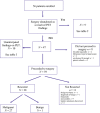A prospective study of the impact of fluorodeoxyglucose positron emission tomography with concurrent non-contrast CT scanning on the management of operable pancreatic and peri-ampullary cancers
- PMID: 25929273
- PMCID: PMC4474510
- DOI: 10.1111/hpb.12418
A prospective study of the impact of fluorodeoxyglucose positron emission tomography with concurrent non-contrast CT scanning on the management of operable pancreatic and peri-ampullary cancers
Abstract
Background: The role of fluorodeoxyglucose (FDG) positron emission tomography (PET/CT) scanning in operable pancreas cancer is unclear. We, therefore, wanted to investigate the impact of PET/CT on management, by incorporating it into routine work-up.
Methods: This was a single-institution prospective study. Patients with suspected and potentially operable pancreas, distal bile duct or ampullary carcinomas underwent PET/CT in addition to routine work-up. The frequency that PET/CT changed the treatment plan or prompted other investigations was determined. The distribution of standard uptake values (SUV) among primary tumours, and adjacent to biliary stents was characterised.
Results: Fifty-six patients were recruited. The surgical plan was abandoned in 9 (16%; 95% CI: 6-26) patients as a result of PET/CT identified metastases. In four patients, metastases were missed and seven were inoperable at surgery, not predicted by PET/CT. Unexpected FDG uptake resulted in seven additional investigations, of which two were useful. Among primary pancreatic cancers, a median SUV was 4.9 (range 2-12.1). SUV was highest around the biliary stent in 17 out of 28 cases. PET/CT detected metastases in five patients whose primary pancreatic tumours demonstrated mild to moderate avidity (SUV < 5).
Conclusions: PET/CT in potentially operable pancreas cancer has limitations. However, as a result of its ability to detect metastases, PET/CT scanning is a useful tool in the selection of such patients for surgery.
© 2015 International Hepato-Pancreato-Biliary Association.
Similar articles
-
Clinical usefulness of 18-fluorodeoxyglucose positron emission tomography in the management of patients with nonpancreatic periampullary neoplasms.Am J Surg. 2006 Jun;191(6):743-8. doi: 10.1016/j.amjsurg.2005.03.042. Am J Surg. 2006. PMID: 16720142
-
Impact of F18-fluorodeoxyglycose positron emission tomography/computed tomography on the management of resectable pancreatic tumours.ANZ J Surg. 2012 Mar;82(3):140-4. doi: 10.1111/j.1445-2197.2011.05972.x. Epub 2012 Jan 17. ANZ J Surg. 2012. PMID: 22510123
-
Utility of contrast-enhanced FDG-PET/CT in the clinical management of pancreatic cancer: impact on diagnosis, staging, evaluation of treatment response, and detection of recurrence.Pancreas. 2013 Jan;42(1):11-9. doi: 10.1097/MPA.0b013e3182550d77. Pancreas. 2013. PMID: 22699206
-
FDG PET/CT in Pancreatic and Hepatobiliary Carcinomas: Value to Patient Management and Patient Outcomes.PET Clin. 2015 Jul;10(3):327-43. doi: 10.1016/j.cpet.2015.03.001. Epub 2015 Apr 16. PET Clin. 2015. PMID: 26099670 Review.
-
Clinical applications of (18)F-FDG PET in the management of hepatobiliary and pancreatic tumors.Abdom Imaging. 2012 Dec;37(6):983-1003. doi: 10.1007/s00261-012-9845-y. Abdom Imaging. 2012. PMID: 22527152 Review.
Cited by
-
Diagnostic accuracy of different imaging modalities following computed tomography (CT) scanning for assessing the resectability with curative intent in pancreatic and periampullary cancer.Cochrane Database Syst Rev. 2016 Sep 15;9(9):CD011515. doi: 10.1002/14651858.CD011515.pub2. Cochrane Database Syst Rev. 2016. PMID: 27631326 Free PMC article. Review.
-
Barriers and enablers to the implementation of protocol-based imaging in pancreatic cancer: A qualitative study using the theoretical domains framework.PLoS One. 2020 Dec 17;15(12):e0243312. doi: 10.1371/journal.pone.0243312. eCollection 2020. PLoS One. 2020. PMID: 33332372 Free PMC article.
-
Clinical Impact of 18F-FDG PET/CT in the Diagnostic Workup of Pancreatic Ductal Adenocarcinoma: A Systematic Review.Diagnostics (Basel). 2020 Dec 3;10(12):1042. doi: 10.3390/diagnostics10121042. Diagnostics (Basel). 2020. PMID: 33287195 Free PMC article. Review.
-
Advances in pre-treatment evaluation of pancreatic ductal adenocarcinoma: a narrative review.J Gastrointest Oncol. 2023 Apr 29;14(2):1114-1130. doi: 10.21037/jgo-22-1034. Epub 2023 Mar 29. J Gastrointest Oncol. 2023. PMID: 37201095 Free PMC article. Review.
References
-
- Oettle H, Post S, Neuhaus P, Gellert K, Langrehr J, Ridwelski K, et al. Adjuvant chemotherapy with gemcitabine vs observation in patients undergoing curative-intent resection of pancreatic cancer: a randomized controlled trial. JAMA. 2007;297:267–277. - PubMed
-
- Neoptolemos JP, Stocken DD, Bassi C, Ghaneh P, Cunningham D, Goldstein D, et al. Adjuvant chemotherapy with fluorouracil plus folinic acid vs gemcitabine following pancreatic cancer resection: a randomized controlled trial. JAMA. 2010;304:1073–1081. - PubMed
-
- Flamen P, Lerut A, Van Cutsem E, De Wever W, Peeters M, Stroobants S, et al. Utility of positron emission tomography for the staging of patients with potentially operable oesophageal carcinoma. J Clin Oncol. 2000;18:3202–3210. - PubMed
-
- Antoch G, Stattaus J, Nemat A, Marnitz S, Beyer T, Kuehl H, et al. Non-small cell lung cancer: dual-modality PET/CT in Preoperative staging. Nucl Med. 2003;229:526–533. - PubMed
Publication types
MeSH terms
Substances
LinkOut - more resources
Full Text Sources
Other Literature Sources
Medical


